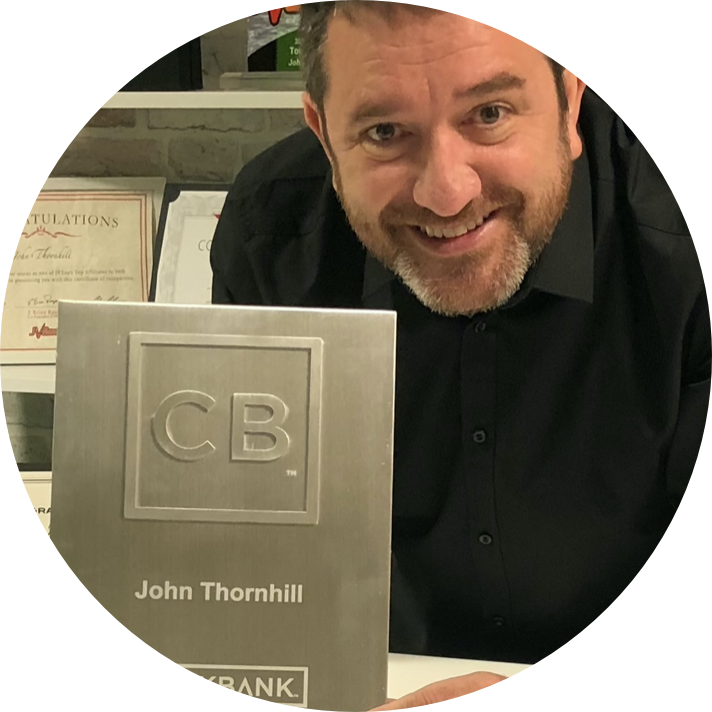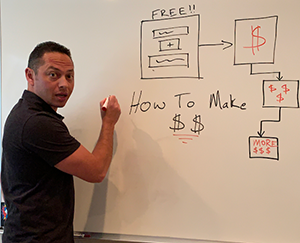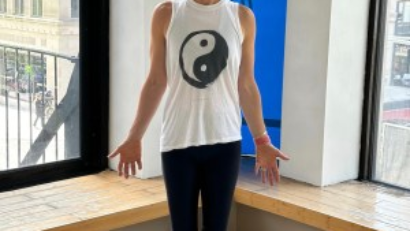How to Master the Science of Learning: From Tetris to Teaching written by John Jantsch read more at Duct Tape Marketing
The Duct Tape Marketing Podcast with John Jantsch In this episode of the Duct Tape Marketing Podcast, I interviewed Scott Young. Through his extensive research and exploration into the science of learning, Scott Young has uncovered fascinating insights into how individuals can master the art of acquiring new skills effectively. In this episode we cover […]
How to Master the Science of Learning: From Tetris to Teaching written by John Jantsch read more at Duct Tape Marketing
The Duct Tape Marketing Podcast with John Jantsch
In this episode of the Duct Tape Marketing Podcast, I interviewed Scott Young. Through his extensive research and exploration into the science of learning, Scott Young has uncovered fascinating insights into how individuals can master the art of acquiring new skills effectively. In this episode we cover the core principles of learning and how they can be applied in various contexts, from mastering video games like Tetris in navigating paths to mastery.
Key Takeaways
Questions I ask Scott Young:
[02:11] Explain the 12 maxims of learning
[03:28] Talk a little bit about your research methodology in uncovering the science of learning?
[06:38] How does gaming intersect with the science of learning, specifically Tetris?
[09:26] Explain how copying is part of the creative process?
[12:25] What is cognitive load theory?
[14:21] How does teaching improve learning?
[19:36] Where can people connect with you and grab a copy of “Get Better at Anything” ?
More About Scott Young:
Like this show? Click on over and give us a review on iTunes, please!
Connect with John Jantsch on LinkedIn
Speaker 1 (00:00): I was like, I found it. I found it. This is what I’ve been looking for. I can honestly say it has genuinely changed the way I run my business. It’s changed the results that I’m seeing. It’s changed my engagement with clients. It’s changed my engagement with the team. I couldn’t be happier. Honestly. It’s the best investment I ever made. What
John (00:17): You just heard was a testimonial from a recent graduate of the Duct Tape Marketing certification intensive program for fractional CMOs marketing agencies and consultants just like them. You could choose our system to move from vendor to trusted advisor, attract only ideal clients, and confidently present your strategies to build monthly recurring revenue. Visit DTM world slash scale to book your free advisory call and learn more. It’s time to transform your approach. Book your call today, DTM World slash scale.
(01:03): Hello and welcome to another episode of the Duct Tape Marketing Podcast. This is John Jantsch. My guest today is Scott Young. He’s a Wall Street Journal bestselling author of the book Ultra Learning, and he’s got a new book out called Get Better At Anything, 12 Maxims four Mastery. His work has been featured in the New York Times Pocket and Business Insider on the BBC and at TEDx among others. He doesn’t promise to have all the answers, just a place to start. And he lives in rainy, sunny Vancouver. I’m not sure which it is. Rainy, sunny Vancouver, Canada is what I was going to say there. So welcome back, Scott.
Scott (01:41): Oh, thanks so much for having me back.
John (01:43): So get better at anything. Pretty bold promise you and I were talking before I hit record and you let me know. You have two young children, so talk about a new thing to get better at. Yeah, yeah,
Scott (02:00): It’s definitely a crash course when you have your first one and then the second one realizes that actually each kid is unique, so you have to do it again over with a new one.
John (02:09): Absolutely. So 12 maxims. So there obviously are 12 ideas in here, but you’ve kind of broken them up into, I don’t know, types of learning. So you want to start there?
Scott (02:22): Well, yeah. So I mean, the idea of the book was to try to find what are the fundamental principles for getting better for improvement for skill acquisition that we’ve learned from cognitive science. And so I broke it into three parts, and I think you need all three to really get better. The first is C, which is learning from other people. And one of the things that came up repeatedly in the research is that the easier time we have learning from others, the faster we’ll make progress. And often when we get stuck, it’s because something in our environment is making it harder for us to learn from the people who are the best. The second factor is do, which is obviously practice is super important for learning, but not just every kind of practice works equally well. So again, there’s also this sort of myth that if you just do something enough, you’ll become really great at it. But the research actually shows that often we stall often we don’t make progress. And so figuring out what kind of practice matters, and then finally feedback, which is obviously important. You need to get this corrective information from the environment about how to adjust what you’re doing. And so the entire book is a deep dive into the many ways that this goes right and wrong, and how you can engineer those in your own efforts at getting better at things.
John (03:28): So talk a little bit about your research methodology. I mean, this is one of those, if you’re going to teach somebody how to get better at stuff here, you’re going to do a lot of experimenting yourself, I’m guessing you’re going to talk to a lot of people. How do you break yours down?
Scott (03:44): Well, I mean, I kind of have a weird background. So as we talked about in my previous book, ultra Learning, which when we had the interview probably about five years ago, my starting point for a lot of this interest in learning was taking on these aggressive, what I call ultra learning projects. So learning MIT’s, computer science, curriculum, learning multiple languages, portrait drawing, quantum mechanics, a bunch of skills. And that was the starting point. But I think once you learn a lot of things, you get very interested in how does it actually work? What are the mechanisms? What are the principles? And so for this book, I wanted to do a much deeper dive in the science of learning. And that’s a bit of a daunting process because it’s not just like there’s one book you can read and it’ll tell you everything. I mean, learning spans, cognitive psychology, neuroscience, anthropology, it spans practical and theoretical. You’ve got people working on artificial intelligence models, and then you’ve got the embodied wisdom of teachers who have taught for decades. And so the research project was sprawling, and I read hundreds of books, probably about six, 700 papers. And so this book I try to do is to try to distill what are the broad patterns? What are the things that are not like, here’s a quirky study, but here’s a broad truth that applies to many different fields, many different ways of getting better at things.
John (05:02): This sounds like a canned question, but I think based on the research way you did it, were there any giant surprises, like you were blown away by something that you learned?
Scott (05:12): Oh, I mean, yeah, writing this book was also an attempt to me to write down the things that surprised me. So I mean, one of the things that surprised me right off the bat was John Schweller’s work that I talk about in it’s the second chapter of the book and this research, he found that through these careful experiments that you can get people to solve problems and they don’t learn how to solve the problem, which sounds like almost like a contradiction in terms how do you solve a problem without learning how you solve it? You
John (05:38): Drink a lot, drink a lot of beer, maybe, or I don’t know. No,
Scott (05:41): I mean, these are people who these find some method to solve it. But then if you ask them, well, what is the method that you’re using to solve it? They can’t articulate it, they can’t remember it. And that has big implications for applying that method to new ones. And so I think that was one of the things that really surprised me. I found Dean Simon’s work on basically creative success being very closely coupled to creative quantity or the amount that you actually produce and publish to also be interesting and full of fascinating implications that don’t get mentioned that often as well. So I mean, the book is just full of my own surprises and my own things that I thought were worth sharing.
John (06:16): I’ve never been a big video game person, frankly. I just feel like it’s not a very good use of my time, especially if you read these studies that people are playing Fortnite for nine hours a day or something like that. But the one game that I kind of got attached to was Tetris because I just felt like there was something different about it. You talk a lot about Tetris, so what do we have to learn from Tetris?
Scott (06:42): I mean, Tetris, this was always a risky gamble, putting it in a book, because there’s people like yourself, I don’t play video games. And then you open with a story about video games and it’s like, am I going to lose some people here? But I think it was a story that when I first heard it, this, I heard this from John Green, he was the YouTuber. He started talking about this, and that’s what triggered me to do all this research about Tetris that I wouldn’t have otherwise done. And the thing that was fascinating about it is that it’s kind of a microcosm everything we need to really know about how learning and improvement works. And it’s the fact that it’s in a domain that most people don’t even think about, I think makes it all the more rewarding. So the basic idea is that Tetris comes out in the early nineties.
(07:21): It’s a phenomenal hit. People are obsessed with it. They’re hallucinating falling blocks, and it’s like a cultural obsession. But if you look at the world record performance, the best people at Tetris, these are the people who are truly obsessed. They’re playing it nonstop. They’re actually not that good at it. And the reason we know they’re not that good at it is that now there’s 12 and 13-year-old kids that are unfathomably better at the game. It’s difficult to put into words how much better they are at the game than they were two decades, three decades ago. So what’s the difference? Why are we suddenly much better at playing Tetris than we used to be? And the answer turns out has a lot to do with how learning works. The environment that people play these video games has transformed radically with the invention of the internet. The way you used to play video games when you were in the early 1990s is like maybe your brother, your brother’s friend, he knows a trick or a strategy, and you hear from him.
(08:11): Or maybe you read something in a magazine, and now it’s online. Now you can watch people play the video game. You can see how their hands move. You can learn the techniques that are at the best frontier of play much more easily. And this has huge implications for learning workplace skills, learning hobbies, learning, all sorts of things that maybe matter more to you than Tetris, which is how do you get access to the best practices, the best techniques, which are often hidden and really do make a big difference in not just your individual performance, but how is a field you’re moving forward and innovating.
John (08:45): Yeah, that makes a ton of sense. I see entire YouTube channels dedicated to just people talking about how they played the game. So yeah, it’s crazy. One at chapter two really got my attention because I’ve been a long believer in this idea that creativity begins with copying. And I think a lot of people have this idea that I’m not creative or I’m not a creator even. But really almost in every field, certainly all of my work has been informed by math or architecture or something else. I read that I was like, oh, I know how I can apply that to what I’m trying to do. So talk a little bit about that idea that copying is actually part of the creative process.
Scott (09:29): I mean, this was a chapter that I’d been wanting to write for years, even before ultra learning had come out, because when I got the chance to spend some longer time in China, one of the things that I found fascinating is how the culture differed from the west. In West, we tend to make creativity and originality as being these polar opposites that either you’re a plagiarist or you’re an original. And we all want to be originals. We don’t want to be people who copy things. And the thing that I really appreciated from the Chinese context is the appreciation of precedent, the appreciation of learning from the masters and the examples that come before. And as I dig in, and I dig into the research here, that this is how we used to teach a lot of things that we now expect people to just be creative and inspiring off the bat that the artistic training, especially I cover the apprenticeship period during the Renaissance, but also in the academy system that came after it.
(10:24): There really was a fairly structured approach to starting with simple examples, copying from masterworks, basically learning the patterns for how to do something successfully, building up this technique so that when you do want to express an idea, when you do want to do something creative, you have all these tools at your disposal. And I think that whether it’s artistic instruction, whether it’s math instruction, whether it’s any kind of field, like this sort of idea that creativity is built off of copying, of understanding examples, of understanding precedent is something that I hate to say is kind of unappreciated in our current culture, which focuses on genius that comes out of nowhere.
John (11:06): There was a book a few years ago, I had Austin on the show called Steal Like an Artist. I don’t know if you’re familiar with that book and the whole book’s about that. It’s a small little book about that whole idea. And I think you’re absolutely right that people really don’t understand that concept. I remember hearing a musician one time say, we’re all using the same eight notes. Nobody’s making up new notes. It’s really just so we’re all borrowing from that kind of reservoir of stuff, and we’re just having new ideas about it.
Scott (11:37): Yeah, I mean, there was a quote from one of the jazz musicians that I covered in a later chapter where we’re talking about variable practice, and he says, I didn’t know how could people do these jazz improvisations just pull something out of thin air? And he’s like, I had no idea the amount of study and knowledge of knowing what had been played before and understanding what had been played before. So people like Quentin Tarantino, for instance, are very do this very nakedly where they’re doing pastiche and doing things that call back to things they like. But pretty much any great artist, that’s what they’re doing. They’re kind of like, I like these three things and I’m going to do them. And it’s just because they have all this knowledge, they have this ability to do it. I mean, it’s so important and it’s something that I think is not stressed enough.
John (12:22): So this isn’t really a question, I just want to hear you talk about cognitive load theory. Yeah,
Scott (12:30): Yeah. Cognitive load theory. Well, I mean it sounds really complicated, but the idea is very central, very central to learning. And it’s again, one of those things that I think if you understand it, it makes sense of a lot of stuff. But the basic idea is that the way our brain works is we have this central bottleneck called working memory. And working memory is kind of think of it as your consciousness, what things you can hold in mind right now at this moment, not things you’re remembering, not things you’ve written down, things that are in your head at that moment. And it’s very narrow. You can only hold a very small amount of information at a time. But to learn things, it has to go through that bottleneck. You have to go through that sort of narrow window of attention. But there’s a little bit of a trick.
(13:11): Once we gain experience in a field, we gain ways to sort of bypass this bottleneck or make it more efficient. So the classic example is if you are learning letters, for instance, if you give someone a sequence of random letters, people will probably be able to remember between five and nine, and then they’re going to have it drop off. But if you reorganize those letters into acronyms that people understand, I think in the book I use N-H-L-F-B-I-M-B-A or something like that, then those nine letters, all of a sudden you can remember it because you’re within that bottleneck. And so this idea that as we learn meaningful patterns from a domain we can handle more information means that so much of getting better is about figuring out not just what is the best method to learn or what’s the best technique, but how do you deal with the fact that when you’re starting out, you can contain deal with a lot less information than you can when you end up. And so this sort of progressive aspect to it of tuning whatever you’re doing to where you’re at in terms of your own cognitive load ability, it’s huge. It underpins so much of learning, and I think it’s again, another underrated factor and improvement.
John (14:20): So tell me where teaching fits into this. Again, you read a book, you maybe try some things, but then you turn around and try to teach somebody else how to do it. Where does that fit into the continuum of getting better?
Scott (14:37): I mean, I think teaching is often very helpful, especially for when you realize, when you’re teaching something, you realize that you often don’t understand something very well, or you can’t articulate that understanding. I have a whole chapter talking about how as you gain experience in something, part of the way we avoid this working memory bottleneck is that components of the skill, mental steps get automated. They become something that we do unconsciously. So we just skip over things and we just get the right answer. And that can make it very hard when you have to communicate to someone because it’s like, well, you went from step one to step nine. What’s two through seven or two through eight? I don’t get it. And it can be hard for you to articulate that. And so this tacit knowledge is often a barrier when you’re teaching something for the first time, you realize, oh, wait, how do I break this down?
(15:22): How do I explain it to someone? But then I think as well, teaching something is also a chance to refine. It’s a chance to make explicit against some of these ideas. When you’re teaching something, you’re often looking for simplifications, you’re looking for ways that you can explain an idea in a way that maybe is not the difficult way that you learned it, but an easier way to make sense of it. And so, I dunno, I think teaching is a very important part of getting a real conceptual understanding or a real explanatory framework for an idea.
John (15:53): Yeah, it’s so funny. As you were describing that, my wife asked me how to do, she’s not a computer person. She asked me how to do stuff all the time. And I’m like, well, I don’t know. I just do it. It’s like, oh, okay, yeah, I guess I’d do that. And then that. But you’re so right about that.
Scott (16:11): Oh yeah.
John (16:12): So alright, there’s a lot of amazing ideas in this book and concepts in this book. How does somebody take the entire book and make it very practical in terms of getting better at something? I mean, is there a framework for take it step one, step two, or is it really more a matter of you’ve got to plug in where you are?
Scott (16:38): Well, I mean, in the last chapter, I give some sort of practical advice for applying it. But in each chapter at the end, I kind of end with, here’s some ways you can apply these ideas. And the way I like to think about it is that if you were to fix a car, for instance, let’s say you have a car that’s broken down on the side of the road, having a mental model of how a car works is going to be really helpful. You’re going to be able to say, oh, okay, the problem here is we have a flat tire, or the problem here is that we’re out of oil. Or the problem here is there’s something rattling around in here. I got to fix something that’s loose. And so in a similar way, I think the main value of a book like this is having that mental model of learning so that you can kind of self-diagnose in some senses, what is the problem?
(17:17): I’m coming out here is the problem that I don’t understand what the best practice is. Is it like a problem of seeing and do I need to join those groups, find those mentors, find those teachers, find that community to get to that best practice. So I’m not figuring it out on my own is the problem practice is the problem that I am wasting a lot of effort doing things that are not moving my skill forward is the problem feedback that I’m not getting enough information about what I’m doing right and wrong. And so if you have these sort of mental models from the book, if you have these ideas, you can kind of steer toward designing techniques that will suit your situation. Because I do think learning is, despite the fact that we just do it instinctively, there’s a lot of complicated stuff going on. And so figuring out what it is you’re doing wrong or figuring out what you’re doing when it’s working well is the first step to making progress into getting yourself unstuck.
John (18:03): I remember when, back in the day when you’d buy a piece of software off the shelf and it would come with a 400 page manual. And I remember literally, I use this example all the time where you could read the whole book and not know how to do anything really. But then you’d go in and start trying to make it do what you wanted it to do and get stuck, and then you could go back and reference the book, or you could go watch a YouTube video on how to do it. And I think a little bit. So in some ways what you’re saying is there’s almost a combination of all of those kinds of things, isn’t there?
Scott (18:36): Yeah. Well, I’m hoping that the kind of person who reads this book is going to be someone who says, you know what? I want to be a better marketer. I want to be a better public speaker. I want to be a better painter, programmer or skier or something like that. They’re going to read the book and they’re going to notice things about what they’re doing. They’re going to notice kind of like, oh, my problem seems to be here. And then they can find techniques that are tailored to that. And so the book does cover a lot of different ideas, but I think that’s just also because there are so many different kinds of troubleshooting steps you could get into. It would be nice if things just, there’s one thing you have to do and you have work all the time, but it is a little bit more like a car breaking down. And you have to be like, okay, what do I need to fix? And so I think that’s why I tried to write the book and tried to cover the ground that I covered to give people the best possible chance of fixing it. Well,
John (19:21): That’s also great advice. I mean, read the book within the context of what you’re trying to get better at, right?
Scott (19:27): Yeah, of course. I mean, it’s always easier when you approach a book like this with some particular concrete goal in mind.
John (19:34): Awesome. Scott, it was great catching up with you for a few minutes. Is there some place you’d invite people to connect with you and obviously pick up a copy of Get Better at anything?
Scott (19:42): Yeah, I mean, everyone can visit my website, scott h young.com. I have a podcast, YouTube channel, a newsletter there all free if you are interested in those things. And then of course, the book is available, Amazon, audible, wherever you get your books, if you’re interested in diving deeper into the science of learning.
John (19:59): Awesome. Well, next time we talk, I want you to have one of your kids come on and I can ask them if you’ve gotten better at being a dad. Okay,
Scott (20:07): Well, we’ll find out. We’ll find
John (20:08): Out. All right. Awesome. Great seeing you again. Hopefully we’ll run into you one of these days again, out there on the road.
Sign up to receive email updates
Enter your name and email address below and I’ll send you periodic updates about the podcast.
Recommended Story For You :

How To Make $3493 Commissions Without Doing Any Selling

Successful dropshippers have reliable suppliers.

People Think I Use A Professional Voiceover Artist. NO! I Just Use Speechelo!

Make Money Testing Apps On Your Phone Or Tablet

Make More Money or Lose Everything

Sqribble Is The ONLY eBook Creator You’ll Ever Need.

Work & Earn as an Online Assistant

Create Ongoing Income Streams Of $500 To $1000 Or More Per Day

It's The Internet's Easiest Side Business.




